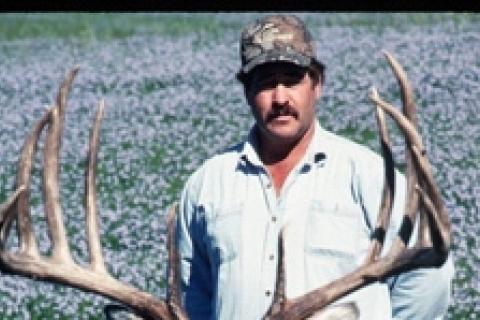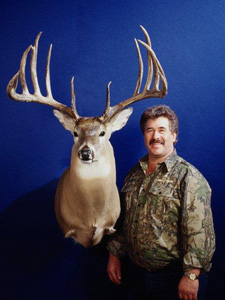
 |
| Milo Hanson and his 213 5/8 world record typical whitetail buck. |
Few whitetail hunters today have enough hunting land available to track a buck for miles until they catch up with it. Most properties are too small for that.
But if you have thick bedding habitat where you hunt, you can use a fresh tracking snow to pinpoint a mature buck. Then execute a quick-strike drive to tag him. That's the tactic Milo Hanson and his hunting partners used to take the world record 213 5/8 typical.
Hanson and three neighbors found the buck's just-made tracks where he entered a willow thicket. One hunter followed the hoof prints while the others covered likely exit points. After several such attempts and several misses, Milo's .308 Winchester lever-action found its mark. The rest is history.
Here are the tactics that made Hanson's hunt a success.
- Time your hunt to take place right after a new snowfall. Fresh snow lets you know you're directly on the heels of a mature buck, not where he was two days ago.
- Methodically search the edges of each prime bedding area on your property until you find a single ember-hot set of large tracks leading into cover, but not out.
- Concentrate on isolated spots near late season food sources that haven't been pressured: gullies, brushy benches, overgrown swamps, remote hollows, clearcuts and thick stream bottoms.
- Position posters on key exit points where a finger of vegetation, brushy ditch or tree line offers some cover for a likely escape route.
- Place another hunter at the next nearby pocket of thick vegetation. Bucks will know where that is and head for it instinctively if they escape the hunters when they break out of the cover.
- Set up posted hunters downwind or crosswind from where the buck is expected to appear.
- Send in the driver working with the wind crossing or in his face. If it's a big pocket of cover, use two drivers, one following the tracks the other slightly downwind and to the side of him in case the buck tries to circle.
- Don't have the driver simply push the cover randomly. He should methodically follow the tracks until he drives out the specific buck he's trailing.
- Work slowly. Speed is not required. Staying on the buck's tracks is. Slip through the cover quietly rather than busting through it. This is late season, and bucks have been pressured hard.
- Don't give up if hunters miss the deer on the first drive. With fresh snow you might get a second, even third chance by tracking the buck to another thicket if the first shots don't connect. Milo took his magnificent buck on the third drive the hunters put on that cold, fateful November day 20 years ago.
Read about the day Milo Hanson scored the big buck in The Story Behind the World Record Whitetail.
- 17426 views

